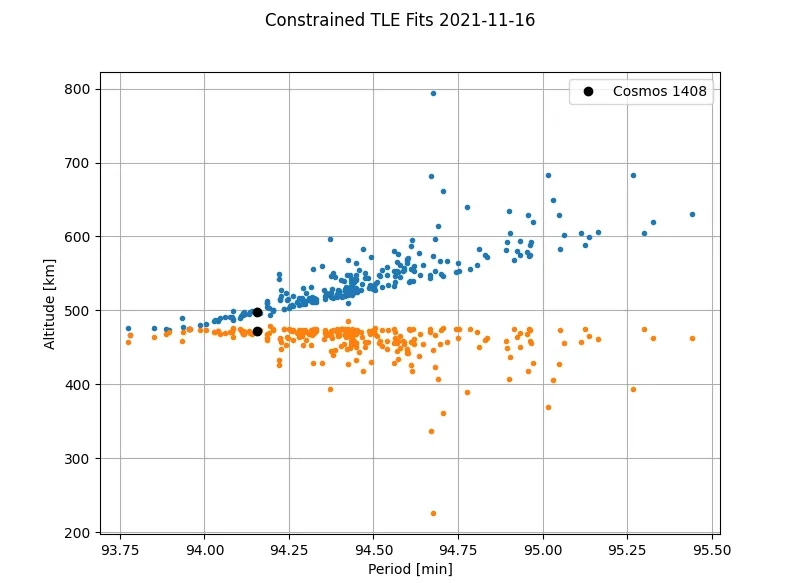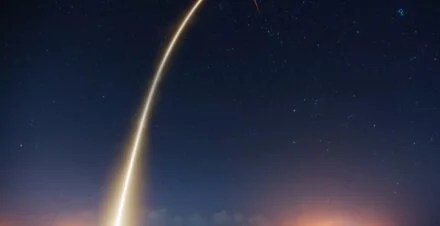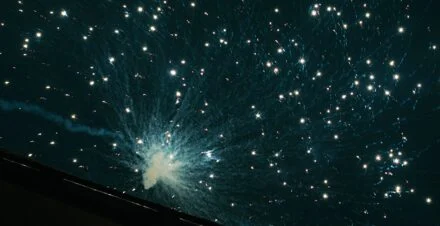In trying to make sense of the debris counts from Cosmos 1408 over the last few days, a few characteristics have been difficult to reconcile. For instance, on the day of the ASAT test Jonathan McDowell noted the potential posigrade tendency of the resulting debris fragments and associated implications.
In the Medium post we released just yesterday (now dubbed “Part I”) with our initial analysis on current and potential debris object counts and distributions, the Gabbard diagram that we released showed a definite skewness toward objects ejected to higher altitudes. This aligns well with the theorized posigrade observations described above.

Gabbard diagram of LeoLabs debris fragments from Cosmos 1408
However, it has been difficult to grapple with the low debris count number observed by our LeoLabs data relative to the large mass of the Cosmos 1408 satellite (~2,200 kg). Frankly, we expected to see many more fragments by now. As we have watched our own identification and characterization rate start to level off (currently at 250–300 unique fragments from Cosmos 1408), it struck us that there was a simple explanation for all of these quandaries.
Our hypothesis up until now is that this was a hypervelocity collision, but there is a possibility that it was not.
Time to do a deep dive into the characteristics of hypervelocity vs. non-hypervelocity impacts, and compare these traits to our observations.
Hypervelocity Space Impacts 101
First, we need to define “hypervelocity.” Hypervelocity for this application is when the impact velocity exceeds the speed of sound in the materials involved. This is typically around 6 km/s for the aluminum and steel structures for aerospace structures (especially from the Cold War era). The table below summarizes the key differences between the results from a hypervelocity collision and a non-hypervelocity collision.

Properties of hypervelocity vs. non-hypervelocity collisions in space
So, in general when objects collide cleanly (i.e., center-of-mass on center-of-mass) at hypervelocity speeds with a sufficiently high projectile energy to mass of target ratio*, the two objects fragment completely, creating a high number of fragments. The Chinese Fengyun 1C ASAT test of 2007 was a classic case of such an event; the satellite basically fragmented isotropically providing very few clues as to the direction of the impactor.
However, when the impact velocity is well below 6 km/s, the resulting debris cloud looks much more like a high-speed terrestrial traffic accident, where investigators can recreate the velocity and direction of the two vehicles by their masses, skid marks, and where they ended up.
Unfortunately, we often just assume that an on-orbit event is hypervelocity because it is far less common to actually have an encounter in low Earth orbit (LEO) at non-hypervelocity speeds. Since the orbital velocity in LEO is around 7.5 km/s:
- A head-on collision would result in a ~15 km/s impact.
- Getting “T-boned” (e.g., impact angle of 90 degrees) the relative impact velocity would be on the order of 10 km/s.
- Even a collision where the two objects travel in generally similar directions at orbital velocities can still result in hypervelocity impact.
As a matter of fact, in examining over one million conjunction events observed by LeoLabs in the last year, the median relative velocity for these events was ~11 km/s. It is no wonder that we assumed this was a hypervelocity encounter.
New Assessment for Cosmos 1408 Fragmentation Counts
If the Russian ASAT impactor approached Cosmos 1408 generally from behind to “rear end” Cosmos 1408 at a relative velocity well below 6 km/s, this would explain both the distribution of posigrade debris and the lower debris count currently observed by LeoLabs. This would also explain the Russian government’s comment this week that debris from the test “would not pose any threat to orbital stations”. What Russia apparently did not know, that breakup modelers are quite aware of, is that non-hypervelocity breakup modeling is very difficult.
Our updated assessment at LeoLabs, based on our observation data and these new insights is that:
The Cosmos 1408 breakup event likely createdmoredebris than Russia anticipated, yetlessdebris than the rest of the world thought, since we initially assumed a hypervelocity impact, as was the case in previous catastrophic collisions.
If (and only if) it is correct that this was a non-hypervelocity impact, we believe the total large debris fragment count is likely to not grow significantly beyond our current count. In addition, estimates for lethal non-trackable (LNT) debris would also be much smaller. This would of course be welcome news, all things considered.
As stated in Part I of this analysis, the one obvious ramification of the good news of fewer pieces of debris is also the bad news that the resulting debris will be larger and more long-lived than typical smaller fragments.
The key takeaways from yesterday’s post remain unchanged: the new debris still poses a threat to the LEO operating environment, and will for years and decades to come. We will continue to monitor this evolution; to identify and characterize the new debris; and report to the community on our findings to focus on space safety for all.
It would demonstrate some level of responsibility for Russia to share the initial conditions of their ASAT test with the international community, to help us characterize the likely debris cloud better and contribute to reducing the potential collision risks to the 95 countries that strive to peacefully share the use of the limited LEO environment.
- *35–45 J/gm determined empirically in 1992. Source: McKnight, D. and Hoyle, S., “Investigation of ANOVA Techniques Applied to Breakup Modeling,” Presented at the 18th International Symposium on Space Technology and Science, Kagoshima, Japan, 17–23 May 1992









